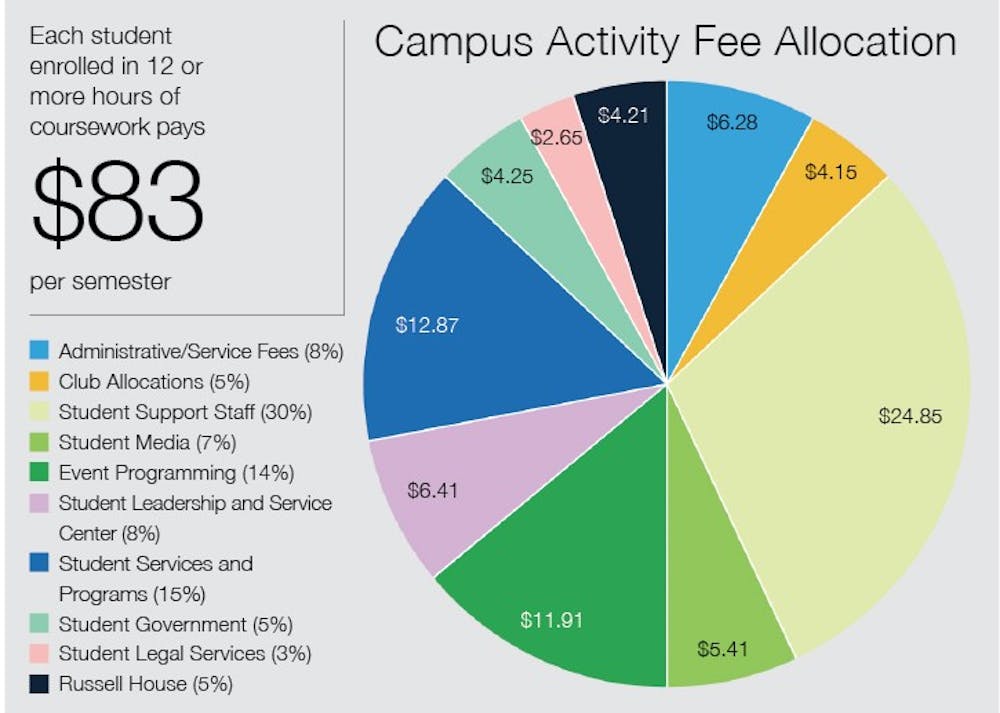What can you buy for $83?
A nice jacket, one and a third video games, a shopping spree at your favorite store or 10 burritos at Moe’s.
But $83 also gets you into either gym on campus, lets you join student organizations and provides you with free movies and concerts, courtesy of Carolina Productions.
All students who take at least 12 credit hours pay a campus activity fee of $83, while other students pay seven dollars per credit hour. This adds up to a grand total of $4,523,861.
“I think the best way to think about this fee is your buy-in to campus life,” said Ryan Harman, Student Government treasurer.
After Student Government executives went to the SEC Exchange, they realized that other universities broke down the numbers of the campus activity fee and published the data to their students.
“The whole goal of this has been to take that information and synthesize and organize it into a format that’s a little bit more accessible to students,” Harman said.
For the campus activity fee allocation report, Harman divided the different university accounts covered by the fee based into categories depending on how they impact the student body.
Administrative services and fees cost students $6.28. This allocation serves as a tax on the use of university infrastructure and has specifically paid for lights, travel and check issuing, among other things, in the past.
Clubs are paid for with $4.15 of the campus activity fee, which covers everything from undergraduate costs to events such as Birdcage and World Night. Sports clubs receive a total of $35,977, while student activities in general receive $191,525. Undergraduate students receive $185,367, or 81 percent, of the activity portion of the fee.
Students pay $24.85 towards student support staff salaries, which are dictated by the Statehouse, and $5.41 for student media.
Campus programming, including Carolina Productions and Carolina After Dark, receives $11.91, while the Student Leadership and Service Center, tasked with Tiger Burn and Homecoming, is given $6.41.
Student services and programs, which is responsible for intramurals and group fitness, receives $12.87. Student government works with a budget of $4.25 from each student per semester.
Student legal services, the newest addition to the campus activity fee, takes $2.65 from each fee. This service deals mostly with landlord-tenant disputes.
“Instead of hiring a lawyer, which could range from thousands, paying $2.65 instead is a real advantage for students,” Student Body President Lindsay Richardson said.
Finally, Russell House receives $4.21, mostly for improvements.
Specifically, Harman and Richardson are hoping to start budget dialogues in November to think more strategically about where students should go in terms of budget. They are hoping to hear qualms about how this money is spent and then begin to address them.
“One thing Lindsay really focused on this semester is developing your thoughts before you use your voice,” Harman said. “The first step is advocating a student thought on the campus life fee.”
Despite the many statistics and graphs in the report, Harman and Richardson hope that students will take away the big picture of trying to make the most of their money.
“I think the best way to look at this, from a student perspective, is looking at that and saying that, for $6.41, are there sufficient resources to make sure that students are getting their money’s worth?” Harman said. “That’s really difficult because it requires you to step back and think about the needs of all students.”
Harman and Richardson hope to produce this data several times each year in the future, but Harman saw this as a “litmus test” to see the initial student reaction.
“Maybe the student body might find this of interest and that’s totally fine,” Richardson said, “but we had to put this out there to see.”

